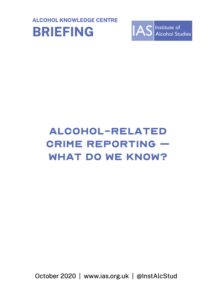View this report

Summary
- Every year, alcohol is associated with 1 million crimes in the UK
- However, there are a range of issues with how crimes are counted which mean the true scale of the issue is likely to be underreported
Introduction
The level of alcohol-related crime that occurs in the UK annually is likely to be an underestimate for several reasons linked to the recording of crimes by the police.
Police recorded crime statistics and crime surveys expose the limitations of data collection.
Alcohol-related crime reporting
The cost of alcohol-related crime
Every year, alcohol is associated with 1 million crimes in the UK [1]. While the Home Office estimates alcohol-related crime to cost UK taxpayers £11bn per year, at 2010/11 prices [2], it has been suggested that this figure – due to the methods and assumptions used to calculate this – may be an underestimate [3].
Underreporting – underestimating the problem
While official figures suggest alcohol-related crime is a substantial issue in the UK, there are a range of issues with how these crimes are counted which mean the true scale of the issue is likely to be underreported.
How are alcohol-related crimes counted?
- Police recorded crime statistics: The Home Office Counting Rules and the National Crime Recording Standard govern police recording practice. Police recorded crime statistics cover all ‘notifiable’ offences recorded by the police for Home Office records [4] (while summary offences may be recorded and published through other channels, such as the figures on failure of roadside breath tests in England & Wales published by the Department for Transport) [5].
- Crime surveys: large-scale crime surveys complement police recorded crime data by including non-notifiable offences, as well as the detailed responses by victims on the specific nature of the crimes suffered. The Crime Survey for England and Wales (CSEW) is based on an annual sample of approximately 35,000 adults and 3,000 children (aged 10 to 15 years) [6]. The Scottish Crime and Justice Survey (SCJS) is based on 12,000 face-to-face interviews conducted with adults (aged 16 or over) every two years [7]. The Northern Ireland Crime Survey (NICS) is based on the responses of approximately 4,000 adults [8]. Crime survey statistics were formerly published as part of the British Crime Survey, although it ceased to include Scotland in its sample in the late 1980s. Some national crime surveys place a special focus on the influence of alcohol on violent crime by asking victims whether they believe their offender(s) to have been under the influence of alcohol at the time of the incident.
However, these statistics have their limitations. Police recorded crime statistics (and statistics published by other government departments collected by police) encounter a range of underreporting issues:
- Most minor summary offences or antisocial behaviour offences are not included in these totals
- Victims may choose not to report crimes to the police for a range of reasons; for example, if they are fearful of repercussions
- Reporting practices may also vary between groups. For example, older people are more likely to report physical violence to the police [9]
- Crimes reported that the police do not record will not be included in this count.
- Inclusion in this count may depend on police detection. For example, unlike crimes against the person, and unless an accident occurs, police must work proactively to discover incidents of drink-driving – through breath tests of motorists for example. This means that figures for these offences are highly sensitive to changes in police practices or resources.
Even for crimes that are reported to and recorded by police, the alcohol-related nature of the crime may not be discovered – except in specific drunk and disorderly cases such as injury caused by drink driving, offenders are rarely tested for the presence of alcohol when caught. In addition to this, the victims of crime incidents may not always be able to detect whether the offender(s) was under the influence of alcohol.
Crime surveys will also be affected by underreporting issues:
- As household surveys, they do not cover crimes committed against businesses.
- Again, victims may choose not to report crimes in such surveys.
- Those living outside a household (for example students living in university halls, those living in institutions or those without a fixed address) are not surveyed.
- These surveys only discuss crimes against the individual; crimes without a defined individual victim (such as criminal damage to public property) will not be counted.
- As a survey which asks people to recall their victimisation experiences, crimes which resulted in a fatality cannot be counted by this measure [10].
The impact of alcohol-related crime is evident from both the police recorded crime statistics and the national crime surveys discussed. However, it is clear there may be alcohol-related crime that goes uncounted, and the scale of the problem may be much greater.
The government’s position
The Coalition Government listed a reduction in alcohol-fuelled violent crime among its core priorities in its 2012 Alcohol Strategy [11]. However, while the 2015 Conservative Government highlighted drugs and alcohol as one of the six key drivers of crime in its Modern Crime Prevention Strategy [12], the 2017 Conservative Government have not focused on alcohol within their Serious Violence Strategy [13].
- Alcohol Health Alliance. 2017. Measuring up: the state of the nation, p. 4
- www.parliament.uk. 2013. Written evidence from the Department of Health (GAS 01), in 3rd report – Government’s Alcohol Strategy, Health Committee
- Bhattacharya, A. 2017. Which cost of alcohol? What should we compare it against? Addiction, 112(4), pp. 559–565
- Home Office. 2013. Crime recording general rules, p. 9
- Department for Transport. 2018. Reported roadside screening breath tests and breath test failures: England and Wales 2001 – 2016 (RAS51016), in Statistical data set: Reported drinking and driving (RAS51)
- Office for National Statistics. 2016. Crime in England and Wales: year ending Mar 2016, p. 44
- Scottish Government. 2018. Scottish Crime and Justice Survey
- Department of Justice. n.d. Northern Ireland Crime Survey
- Australian Institute of Criminology. 2000. Alcohol and Other Drug-Related Violence and Non-Reporting, p. 1
- Hansard. 2014. Alcoholic Drinks: Crime, Column 696W
- HM Government. 2012. The Government’s Alcohol Strategy, pp. 8–9
- HM Government. 2016. Modern Crime Prevention Strategy, p. 4
- HM Government. 2018. Serious Violence Strategy, p. 15
View this report
